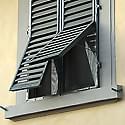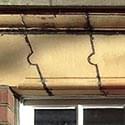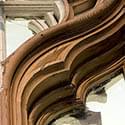
jalousie, hinged or horizontally sliding external sunscreen consisting of fixed or rotatable slats or louvres.
Continental versions may include a bottom section that swings out (as shown) to maximise ventilation at certain times of day. The louvres in the top and bottom panels may also be adjusted independently of each other. The function of louvres is fully understood in Mediterranean countries, whereas in Britain external shutters are mostly decorative and tend always to be mounted the wrong way round, so that if ever closed over the window they would allow in both sunlight and rain, rather than keeping them out.
jamb, the vertical side of an opening, or the vertical side member of a window or door [French: jambe, leg].
See also return and reveal.
jealous glass, the name given in the eighteenth century to a form of obscured glass.
Richard Neve, in The City and Country Purchaser and Builders’ Dictionary, 1726, says “this is a sort of a wrinkled glass of such a Quality, that one cannot distinctly see what is done on the other side of it; but yet it admits the Light to pass through it . . . This sort of glass is commonly used, in and about London, to put into the lower Lights of Sash–windows etc. where the windows are low against the Street, to prevent People’s seeing what is done in the Room as they pass by . . .”

joggled voussoir, one in which the line of the joint has been broken, or a projection introduced, in order the prevent the faces from sliding against each other.
See voussoir.

joinery, the art or occupation of a joiner, who constructs things by joining pieces of wood.
The Oxford English Dictionary goes on to say that ‘a joiner is a worker in wood who does lighter and more ornamental work than that of a carpenter, as the construction of the furniture and fittings of a house, ship etc.’ We might add that his work in not as fine as that of a cabinet–maker, who also works in wood — unlike the carpenter who works in timber. Overlaps occur between the two trades, and fiercely fought demarcation disputes have arisen in the past. In his Mediaeval Craftsmen, 1975, John Harvey notes that ‘in strict principle, the mark of joinery is the use of the plane, and one might add that the joiner uses glue’. The joiner’s tools are specific to his purpose, and would be of relatively little use to the other woodworking trades — wheelwrights, cartwrights, millwrights, bowyers fletchers, coopers, or saddlers. By the time the example shown was being created (in the last quarter of the nineteenth century) hand tools had been replaced by steam–driven mechanical tools capable of the mass–production of such elaborately constructed windows.
judas, judas–hole, a small lattice or aperture in a shutter or door (as in a prison cell) through which a person may see without being seen; a peep–hole.


